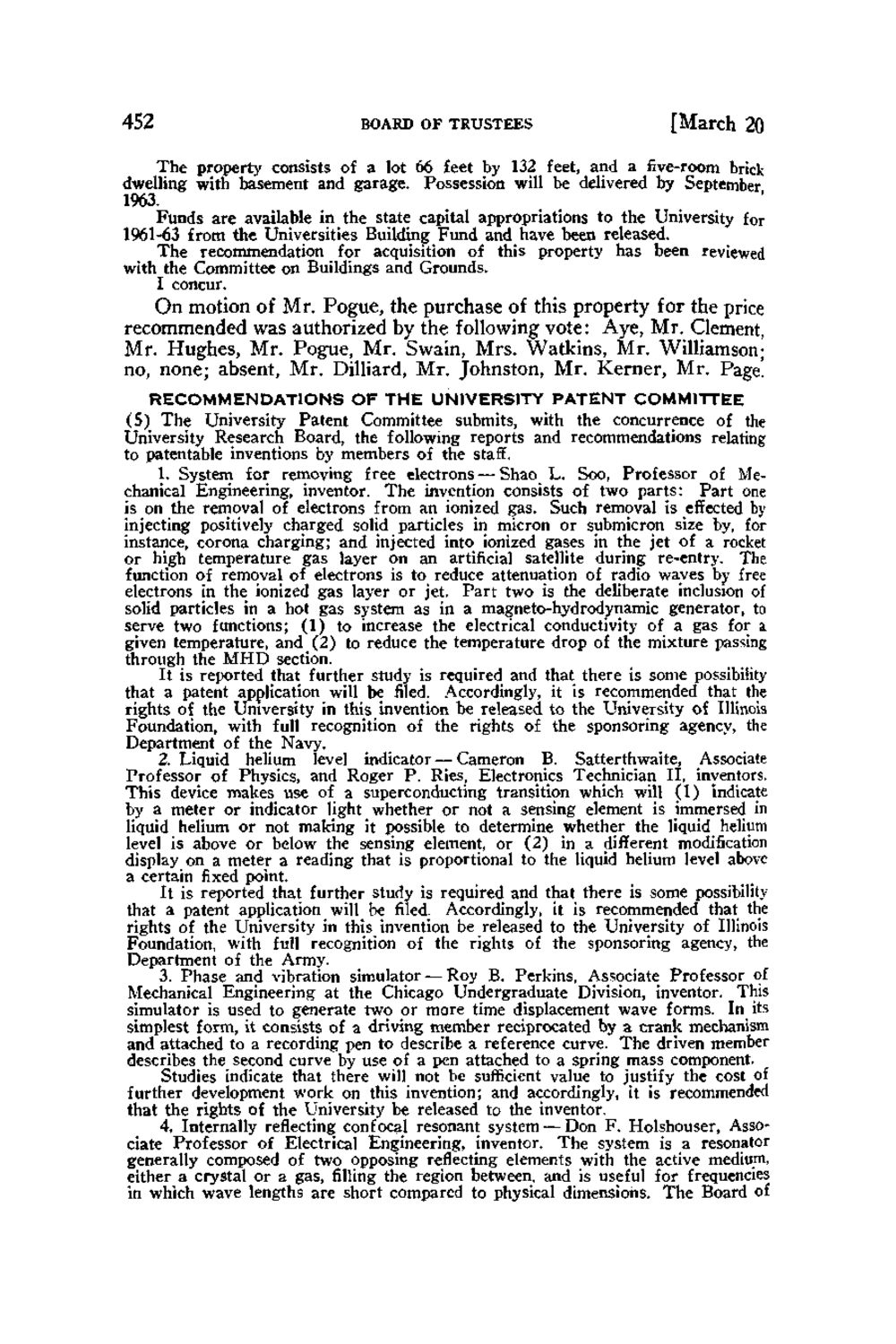| |
| |
Caption: Board of Trustees Minutes - 1964
This is a reduced-resolution page image for fast online browsing.

EXTRACTED TEXT FROM PAGE:
452 BOARD OF TRUSTEES [March 20 The property consists of a lot 66 feet by 132 feet, and a five-room brick dwelling with basement and garage. Possession will be delivered by September 1963. ' Funds are available in the state capital appropriations to the University for 1961-63 from the Universities Building Fund and have been released. The recommendation for acquisition of this property has been reviewed with the Committee on Buildings and Grounds. I concur. On motion of Mr. Pogue, the purchase of this property for the price recommended was authorized by the following vote: Aye, Mr. Clement, Mr. Hughes, Mr. Pogue, Mr. Swain, Mrs. Watkins, Mr. Williamson; no, none; absent, Mr. Dilliard, Mr. Johnston, Mr. Kerner, Mr. Page. R E C O M M E N D A T I O N S O F T H E UNIVERSITY PATENT COMMITTEE (5) The University Patent Committee submits, with the concurrence of the University Research Board, the following reports and recommendations relating to patentable inventions by members of the staff. 1. System for removing free electrons — Shao L. Soo, Professor of Mechanical Engineering, inventor. The invention consists of two parts: Part one is on the removal of electrons from an ionized gas. Such removal is effected by injecting positively charged solid particles in micron or submicron size by, for instance, corona charging; and injected into ionized gases in the jet of a rocket or high temperature gas layer on an artificial satellite during re-entry. The function of removal of electrons is to reduce attenuation of radio waves by free electrons in the ionized gas layer or jet. Part two is the deliberate inclusion of solid particles in a hot gas system as in a magneto-hydrodynamic generator, to serve two functions; (1) to increase the electrical conductivity of a gas for a given temperature, and (2) to reduce the temperature drop of the mixture passing through the M H D section. It is reported that further study is required and that there is some possibility that a patent application will be filed. Accordingly, it is recommended that the rights of the University in this invention be released to the University of Illinois Foundation, with full recognition of the rights of the sponsoring agency, the Department of the Navy. 2. Liquid helium level indicator — Cameron B. Satterthwaite, Associate Professor of Physics, and Roger P . Ries, Electronics Technician II, inventors. This device makes use of a superconducting transition which will (1) indicate by a meter or indicator light whether or not a sensing element is immersed in liquid helium or not making it possible to determine whether the liquid helium level is above or below the sensing element, or (2) in a different modification display on a meter a reading that is proportional to the liquid helium level above a certain fixed point. It is reported that further study is required and that there is some possibility that a patent application will be filed. Accordingly, it is recommended that the rights of the University in this invention be released to the University of Illinois Foundation, with full recognition of the rights of the sponsoring agency, the Department of the Army. 3. Phase and vibration simulator — Roy B. Perkins, Associate Professor of Mechanical Engineering at the Chicago Undergraduate Division, inventor. This simulator is used to generate two or more time displacement wave forms. In its simplest form, it consists of a driving member reciprocated by a crank mechanism and attached to a recording pen to describe a reference curve. The driven member describes the second curve by use of a pen attached to a spring mass component. Studies indicate that there will not be sufficient value to justify the cost of further development work on this invention; and accordingly, it is recommended that the rights of the University be released to the inventor. 4. Internally reflecting confocal resonant system — Don F. Holshouser, Associate Professor of Electrical Engineering, inventor. The system is a resonator generally composed of two opposing reflecting elements with the active medium, either a crystal or a gas, filling the region between, and is useful for frequencies in which wave lengths are short compared to physical dimensions. The Board of
| |